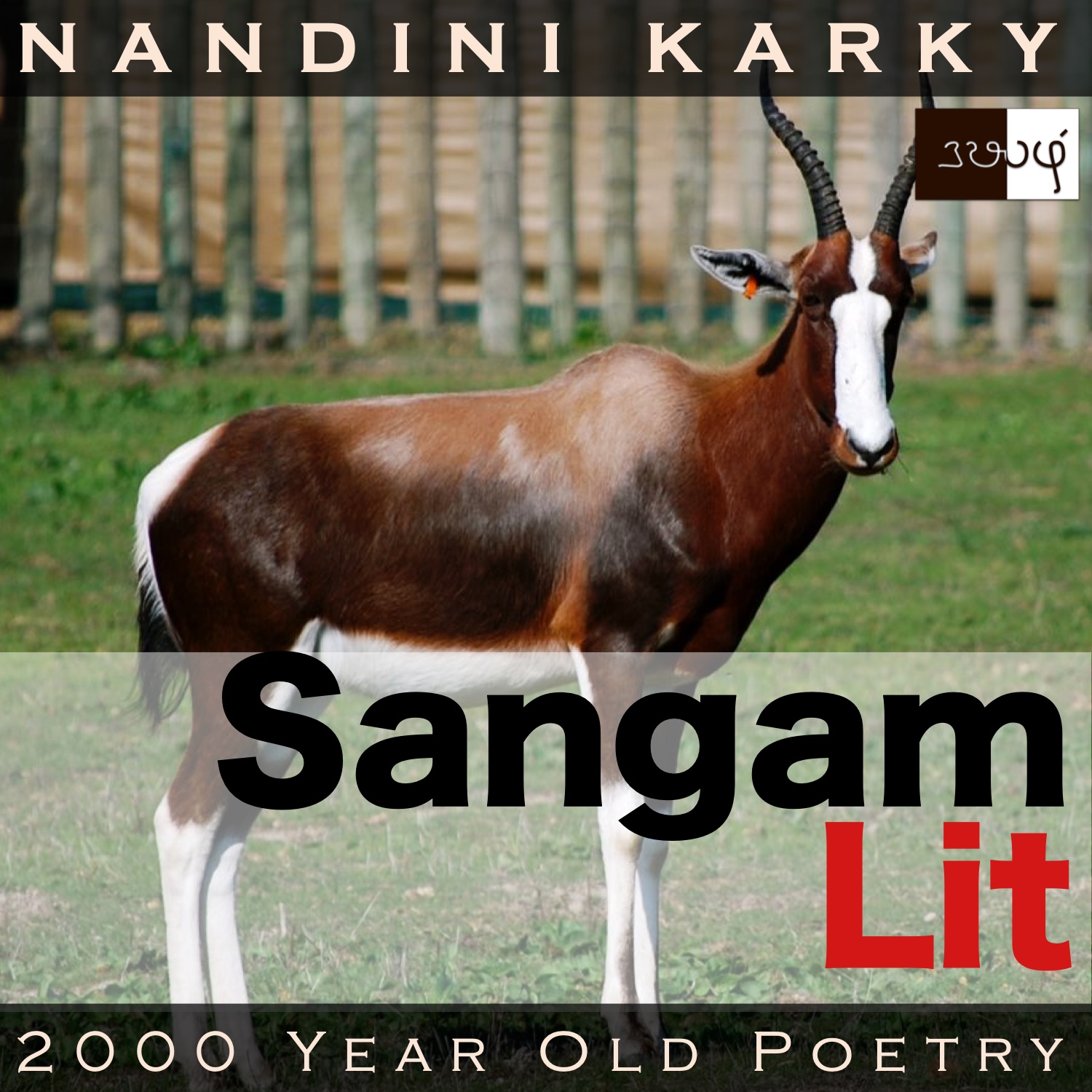Podcast: Play in new window | Download
Subscribe: Apple Podcasts | Spotify | Amazon Music | Android | iHeartRadio | Email | TuneIn | RSS | More

In this episode, we relish picturesque references to wildlife, depicting the love life of the protagonists, as portrayed in Sangam Literary work, Kurunthogai 317, penned by Madurai Kandarathathanaar. The verse is situated in the mountains of ‘Kurinji’ and speaks in the voice of the confidante to the lady, consoling the lady that the man would return soon from his travels.
புரி மட மரையான் கரு நரை நல் ஏறு
தீம் புளி நெல்லி மாந்தி, அயலது
தேம் பாய் மா மலர் நடுங்க வெய்து உயிர்த்து,
ஓங்கு மலைப் பைஞ் சுனை பருகும் நாடன்
நம்மை விட்டு அமையுமோ மற்றே-கைம்மிக
வட புல வாடைக்கு அழி மழை
தென் புலம் படரும் தண் பனி நாளே?
‘How can he stay away?’ is the question raised here. In the opening words ‘புரி மட மரையான் கரு நரை நல் ஏறு’, we glimpse at the description of an animal family, for it talks about both ‘the beautiful, naive, female black buck’ and ‘its handsome, dark male with greys’. When you search for the defining characteristics of the male and female of this species, you will learn that the male is darker in colour than the female, which are uniformly tan-coloured. Also, while the female is plain and monochromatic, the male has a two-tone striking pattern, black on the outside with white patches around the eyes, chin, underside and inner legs. Isn’t it stunning how all these multiple lines we have used to differentiate the male and female is casually and compactly presented in a single line of ancient Tamil poetry? Such acute observations and dense expressions by Sangam poets never fails to amaze me! Returning to the poem, next we ‘தீம் புளி நெல்லி மாந்தி’ meaning ‘eating sour gooseberries’, a phrase that makes my mouth water instantly. From eating, we turn to drinking in ‘ஓங்கு மலைப் பைஞ் சுனை பருகும்’ meaning ‘savouring the fresh spring waters in the high hills’. To the skies, the verse next takes us in ‘வட புல வாடை’ meaning ‘the cold winds from the north’. Ending with the words ‘தண் பனி நாளே’ meaning ‘the moist and cold days’, the verse invites us to soak in the meanings within.
Biology in one half and climatology in the other half of this vivid verse! The context reveals that the man and lady were leading a love relationship when the man parted away to gather wealth for their wedding. The lady languishes and loses her health in his absence. Observing her friend’s anxiety, the confidante says to her, “The fine, dark male with white patches, mate of the alluring and innocent female black buck, eats the sweet and sour gooseberry, and then, making the nearby honey-dripping huge flowers shiver with its hot breath, it drinks from the fresh springs in the soaring mountains of the lord. How can he stay away from you, in those moist and cold days, when the excessively strong northern winds scatter the rain clouds, making them move south?”. With these words, the confidante assures the lady that the man would return before the difficult season of rains commenced.
A black buck seems to hold the key to the lady’s peace of mind. Let’s observe how by listening to the confidante’s words closely. She starts by talking about a female black buck, and we know this because she addresses the animal as ‘innocent’ and that’s an adjective reserved for females, both human and animal in Sangam Literature! After mentioning this innocent animal, the confidante instantly turns to talk about its mate, the male black buck, with its black and white handsome appearance. From the appearance of the animal, the confidante moves to talk about its activities, from how the buck eats sour gooseberries and then, making the huge flowers in its path shiver with its hot sigh, it goes on to drink the waters in the hills of the man’s mountains. After describing the man’s land so, the confidante asks a rhetorical question to the lady about how is it even possible for the man to stay away from the lady, on those cold days when the northern winds push the rain clouds south, making them pour on the lands beneath?
To truly relish this verse, we need to taste the sour gooseberries like the black buck. A point to be noted is that gooseberry trees are representative of the ‘Paalai’ or drylands region and not the mountains where this verse is set. Why has the poet placed this incongruous tree in this landscape? The answer to the question lies in the brilliant placement of a metaphor, that of the man seeking wealth in the harsh drylands, in this image of the blackbuck eating gooseberries. This is the man’s current situation but again in the image of the animal drinking sweet water in the mountains, another metaphor for the man returning to the lady and relishing a happy life with her is hidden. It’s a well-known fact that drinking water after eating sour gooseberries renders an extraordinary sweetness in the throat. And, that is the promise the confidante renders to the lady that though the present may present sour challenges to her, soon sweetness shall surround the lady. This, the confidante further stresses by depicting the man’s thoughtfulness for he will not remain away from her, when the northern winds and cold rain are about to pour to torment the lady. What an apt expression for bringing calm to an anxious heart! The Sangam folks tell us that consoling someone is an intricate art that must appeal both to the heart and mind of the listener, and fill them with positivity, even though there is be none around!




Share your thoughts...